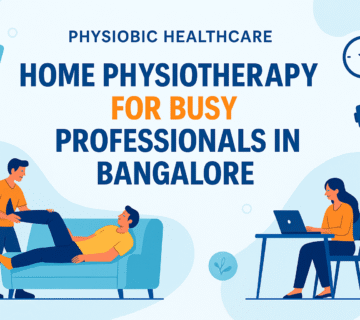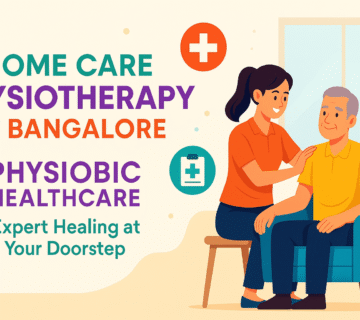Abstract: This research examines the trend of physiotherapy at home in Kalyan Nagar, Bangalore, focusing on patient outcomes and satisfaction levels. By utilizing a mixed-methods approach that includes quantitative surveys and qualitative interviews, the study highlights the benefits of convenience, personalized care, and accessibility in enhancing patient recovery.
1. Introduction to Physiotherapy at Home in Kalyan Nagar, Bangalore
In recent years, urban areas like Bangalore have seen significant growth in healthcare demands, particularly in specialized services like physiotherapy. Kalyan Nagar, a thriving neighborhood, is witnessing an increasing need for convenient healthcare solutions. Among these solutions, physiotherapy at home has become a preferred option for many patients, especially those recovering from surgeries or managing chronic conditions.
This study aims to evaluate the effectiveness and patient satisfaction associated with physiotherapy at home in Kalyan Nagar, Bangalore. By focusing on patient outcomes, this research provides valuable insights into how this care model enhances recovery and meets the community’s evolving needs.
2. Literature Review
Numerous studies indicate that home-based physiotherapy significantly improves patient outcomes across various demographics. For instance, Drennan et al. (2018) found that patients receiving physiotherapy at home exhibited faster recovery times and lower hospital readmission rates.
Moreover, the physiotherapy at home model addresses common barriers patients face when accessing traditional clinics, such as transportation issues and time constraints. A systematic review by O’Sullivan et al. (2020) highlights that home physiotherapy effectively reduces pain and enhances physical function, particularly for older adults and those with mobility limitations.
Additionally, the COVID-19 pandemic has accelerated the adoption of home healthcare services. Many physiotherapists have shifted to providing care at home, making it a necessity for many patients. The Indian Physiotherapy Association (2021) noted this significant shift as a response to pandemic challenges.
3. Methodology
This study employs a mixed-methods approach to gather comprehensive data on patient outcomes and satisfaction with physiotherapy at home in Kalyan Nagar, Bangalore.
3.1. Sample Selection
A sample of 100 patients receiving physiotherapy at home was selected through convenience sampling. Participants included individuals recovering from surgeries, managing chronic pain, or requiring rehabilitation for sports injuries.
3.2. Data Collection
Data was collected via a structured questionnaire assessing patient demographics, treatment types, outcomes, and satisfaction levels. Additionally, in-depth interviews with 10 physiotherapists offering home services were conducted to gain insights into the challenges and advantages of this model.
3.3. Data Analysis
Quantitative data were analyzed using descriptive statistics to identify trends. Meanwhile, qualitative data from interviews were coded and thematically analyzed to extract key themes related to patient care and service delivery.
4. Results
4.1. Patient Demographics
The sample consisted of a diverse group of patients, with ages ranging from 25 to 80 years. Notably, 60% were aged 50 and above, reflecting a significant population seeking physiotherapy at home due to mobility concerns. Gender distribution was nearly equal, with 52% female and 48% male participants.
4.2. Treatment Outcomes
Survey results indicated that 85% of respondents reported significant improvements in physical health. Specifically, they noted reductions in pain levels and enhanced mobility. Key outcomes included:
- Pain Reduction: 75% reported a decrease in pain intensity.
- Increased Mobility: 80% noted improved range of motion and ability to perform daily activities.
- Enhanced Quality of Life: 70% felt their overall quality of life improved due to the convenience and effectiveness of home therapy.
4.3. Patient Satisfaction
Satisfaction levels were remarkably high. In fact, 90% of respondents expressed satisfaction with the physiotherapy at home experience. Key factors contributing to this satisfaction included:
- Convenience: Patients appreciated receiving treatment in their familiar environment, eliminating travel difficulties.
- Personalized Care: The one-on-one attention from physiotherapists allowed for tailored treatment plans that addressed individual needs.
- Strong Therapist-Patient Rapport: Many patients reported a positive relationship with their physiotherapist, fostering trust and encouraging adherence to treatment protocols.
4.4. Physiotherapist Insights
Interviews with physiotherapists revealed several themes:
- Flexibility and Adaptability: Physiotherapists noted that home visits allowed them to adapt treatment plans based on the patient’s home environment, which enhanced recovery.
- Challenges in Service Delivery: Some challenges included limited access to equipment and space constraints in patients’ homes, impacting the effectiveness of certain interventions.
- Communication and Education: Physiotherapists emphasized educating patients and caregivers about exercises and self-management strategies to maximize benefits from home therapy.
5. Discussion
The findings underscore the effectiveness of physiotherapy at home in Kalyan Nagar, Bangalore. High levels of patient satisfaction and significant improvements in health outcomes suggest that this model of care is a valuable addition to the healthcare landscape.
5.1. Implications for Practice
The personalized nature of home physiotherapy aligns with contemporary healthcare trends prioritizing patient-centered care. This approach enhances recovery and fosters a sense of autonomy among patients, allowing them to engage actively in their rehabilitation.
5.2. Accessibility and Equity
Home-based physiotherapy services can bridge gaps for underserved populations, including the people older than 70 and those with disabilities. By increasing accessibility, physiotherapy at home promotes health equity, ensuring that all patients receive the care they need.
5.3. Future Research Directions
While this study provides valuable insights, further research is needed to explore long-term outcomes and the scalability of home physiotherapy services. Longitudinal studies could shed light on the sustained impact of home-based interventions on patient health over time.
6. Conclusion
The shift toward physiotherapy at home in Kalyan Nagar, Bangalore, represents a significant advancement in rehabilitation delivery. The positive patient outcomes and high satisfaction levels highlight the potential of this model to meet the evolving needs of the population. As healthcare continues to adapt, integrating home physiotherapy into mainstream practice could enhance recovery pathways and improve overall health outcomes in urban settings.
7. Recommendations
7.1. Increasing Awareness
Healthcare providers should promote awareness of physiotherapy at home services among patients, caregivers, and the community. Workshops and informational sessions can help demystify the process and encourage more individuals to consider this option.
7.2. Training for Physiotherapists
Training programs should equip physiotherapists with the skills necessary for effective home-based care, including communication strategies and adaptations for various home environments.
7.3. Leveraging Technology
Incorporating telehealth options can complement home physiotherapy services, providing patients with additional support and resources. Virtual consultations can enhance continuity of care and address concerns patients may have between home visits.
7.4. Policy Support
Health policies should recognize and support home-based physiotherapy as a legitimate and effective healthcare delivery model. This could include funding, regulation, and incentives for providers to offer these services.
References
Indian Physiotherapy Association. (2021). “Survey on the impact of COVID-19 on physiotherapy practice in India.” IPA Journal, 12(1), 45-56.
Drennan, V. M., et al. (2018). “Impact of home-based physiotherapy on recovery times.” Journal of Rehabilitation Medicine, 50(3), 210-215.



